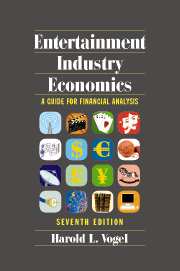Book contents
- Frontmatter
- Contents
- Preface
- Entertainment Industry Economics
- Part I Introduction
- Part II Media-dependent entertainment
- Chapter 3 Movie macroeconomics
- Chapter 4 Making and marketing movies
- Chapter 5 Financial accounting in movies and television
- Chapter 6 Music
- Chapter 7 Broadcasting
- Chapter 8 Cable
- Chapter 9 Publishing
- Chapter 10 Toys and games
- Part III Live entertainment
- Part IV Roundup
- Appendix A Sources of information
- Appendix B Major games of chance
- Appendix C Supplementary data
- Glossary
- References
- Index
- References
Chapter 3 - Movie macroeconomics
from Part II - Media-dependent entertainment
Published online by Cambridge University Press: 22 August 2009
- Frontmatter
- Contents
- Preface
- Entertainment Industry Economics
- Part I Introduction
- Part II Media-dependent entertainment
- Chapter 3 Movie macroeconomics
- Chapter 4 Making and marketing movies
- Chapter 5 Financial accounting in movies and television
- Chapter 6 Music
- Chapter 7 Broadcasting
- Chapter 8 Cable
- Chapter 9 Publishing
- Chapter 10 Toys and games
- Part III Live entertainment
- Part IV Roundup
- Appendix A Sources of information
- Appendix B Major games of chance
- Appendix C Supplementary data
- Glossary
- References
- Index
- References
Summary
You oughta be in pictures!
A more appealing pitch to investors would be hard to find. Many people imagine that nothing could be more fun and potentially more lucrative than making movies. After all, in its first four years, Star Wars returned profits of over $150 million on an initial investment of $11 million (and many millions more on re-release 20 years later). Nonetheless, ego gratification rather than money may often be the only return on an investment in film. As in other endeavors, what you see is not always what you get. In fact, of any ten major theatrical films produced, on the average, six or seven may be broadly characterized as unprofitable and one might break even. Still, as we shall soon discover, there are many reasons why such characterizations must be applied with care and why the success ratio for studio/distributors is considerably better than for individual participants.
Be that as it may, moviemaking is still truly entrepreneurial: It is often a triumph of hope over reality, where defeat can easily be snatched from the jaws of victory. But its magical, mystical elements notwithstanding, it is also a business, affected as any other by basic economic principles.
This chapter is concerned with macroeconomic trends and movie asset valuations; the next two chapters deal with issues of operational structure, accounting, and television-related microeconomics.
- Type
- Chapter
- Information
- Entertainment Industry EconomicsA Guide for Financial Analysis, pp. 65 - 105Publisher: Cambridge University PressPrint publication year: 2007



